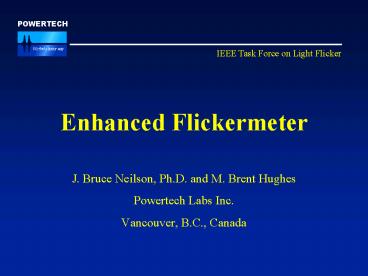Enhanced Flickermeter - PowerPoint PPT Presentation
1 / 22
Title:
Enhanced Flickermeter
Description:
Assess flicker emission coming from an individual customer. ... Measure voltage flicker at a customer's point of common coupling with and ... – PowerPoint PPT presentation
Number of Views:582
Avg rating:3.0/5.0
Title: Enhanced Flickermeter
1
Enhanced Flickermeter
- J. Bruce Neilson, Ph.D. and M. Brent Hughes
- Powertech Labs Inc.
- Vancouver, B.C., Canada
2
Measurement Objectives
- Measure voltage flicker seen by customers.
- Assess flicker emission coming from an individual
customer. - Assess background flicker coming from other
customers or the utility.
3
Present Method
- Measure voltage flicker at a customers point of
common coupling with and without their load
operating. - The difference between the two is an estimate of
that customers contribution to the flicker at
that location. - The measurement made without the customers load
operating is an estimate of the background
flicker. - The shortcoming is that the background flicker
may be different between these two measurements.
This may lead to an incorrect estimate of the
customers flicker.
4
Enhanced Measurement
- Measure the customers current as well as
voltage. - Estimate the utilitys source impedance and
voltage. - Calculate what the voltage would have been for
the customers load only and a constant utility
equivalent. This is the flicker the customer is
responsible for. - Derive the difference between the measured and
customers calculated voltage. This is the
background flicker that the utility and/or other
customers are responsible for.
5
Flickermeter Implementation
- The basic flickermeter is IEC 868 compliant with
the 120V adaptation for North America. - It is implemented in Labview on an NEC portable
PC with using a National Instruments A/D pc card. - All calculations are done with cycle-by-cycle
60Hz vector quantities.
6
Circuit Diagram
Utility
Load
7
Circuit Diagram
Utility
Measure Vpcc Iload
Pst10pcc
Load
8
Circuit Diagram
Utility
Calc. Z ?V/?I
Measure Vpcc Iload
Pst10pcc
Load
9
Circuit Diagram
Utility
Calc. Z ?V/?I
Measure Vpcc Iload
Pst10pcc
Calc. Vemission Econst. - Iload Z
Pst10emission
Load
assumed
10
Circuit Diagram
Utility
Calc. Vbackground Vpcc Iload Z
Pst10background
Calc. Z ?V/?I
Measure Vpcc Iload
Pst10pcc
Calc. Vemission Econst. - Iload Z
Pst10emission
Load
assumed
11
Circuit Diagram
Utility
Calc. Vbackground Vpcc Iload Z
Pst10background
Calc. Z ?V/?I
New Direct Measurements
Measure Vpcc Iload
Pst10pcc
Calc. Vemission Econst. - Iload Z
Pst10emission
Load
assumed
12
Wood Chipper
Background
Measured
All flicker caused by customers chipper
Calculated
13
Utility Impedance
Plot of V vs. I for a single event known to be
caused by customer
Z ?V / ?I (slope of line)
14
Background Motor Start
Background
Measured
Separate external events from customer caused
flicker
Calculated
15
Wood Chipper Pst10
More background than customer flicker
Two external motor starts
Chipper 1 start - CT saturates
Chipper 2 start
Measured
Background
Calculated
Chipper idle
16
Flicker Countermeasures
- Utility added Dstatcom to counteract voltage
flicker - Effect of Dstatcom is incorporated in background
- If Dstatcom current is measured Dstatcom effect
can be separated from background
Utility
pcc
Dstatcom
Load
17
(No Transcript)
18
Wood Chipper with Dstatcom
Background Dstatcom
Dstatcom turned on
Measured
Calculated
Voltage dips reduced smoothed
19
Dstatcom in Vhold mode
Background Dstatcom
Vhold mode turned on
Measured
Calculated
20
Dstatcom in Vhold mode
Background Dstatcom
Vhold setpoint increased
Measured
Dstatcom output limit reached
Calculated
21
Wood Chipper Pst10
Background event Remote 230kV fault
Dstatcom turned on measured lt calculated
Calculated
Measured
Background
22
Conclusion
- This enhanced flicker measurement technique
provides a real-time, direct, and simultaneous
measurement of - the total flicker at the point-of-common-coupling
- the flicker caused by the customer
- the background flicker already on the utility
supply - the flicker improvement provided by
countermeasures































